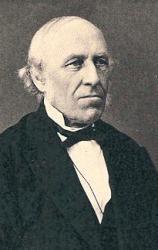Planning worship?
Check out our sister site, ZeteoSearch.org,
for 20+ additional resources related to your search.
- |
User Links
Person Results
Anonymous
Person Name: Ukj. Translator of "O kom dog hver, som Synd har gjort" in M. B. Landstads Kirkesalmebog og "Nokre Salmar" ved Professor Dr. E. Blix, samt følgende tillæg In some hymnals, the editors noted that a hymn's author is unknown to them, and so this artificial "person" entry is used to reflect that fact. Obviously, the hymns attributed to "Author Unknown" "Unknown" or "Anonymous" could have been written by many people over a span of many centuries.
Anonymous
Ludvig Mathias Lindeman

1812 - 1887 Person Name: Ludv. M. Lindeman Composer of "[O kom dog hver, som Synd har gjort]" in M. B. Landstads Kirkesalmebog og "Nokre Salmar" ved Professor Dr. E. Blix, samt følgende tillæg Ludvig M. Lindeman (b. 1812; d. 1887) was a Norwegian composer and organist. Born in Trondheim, he studied theology in Oslo where he remained the rest of his life. In 1839 he succeeded his brother as the organist and cantor of Oslo Cathedral, a position he held for 48 years up until his death. Lindeman was appointed Knight of the Royal Norwegian Order of St. Olav, and was invited to both help christen the new organ in Royal Albert Hall in London, as well as compose for the coronation of King Oscar II and Queen Sophie of Sweden. In 1883, he and his son started the Organist School in Oslo. Lindeman is perhaps best known for his arrangements of Norwegiam folk tales; over the course of his life he collected over 3000 folk melodies and tunes.
Laura de Jong
Ludvig Mathias Lindeman
Leopold Franz Friedrich Lehr
1709 - 1744 Person Name: L. Lehr Author of "O kom dog hver, som Synd har gjort" in M. B. Landstads Kirkesalmebog og "Nokre Salmar" ved Professor Dr. E. Blix, samt følgende tillæg Lehr, Leopold Franz Friedrich, son of Johann Jakob Lehr, Hofrath at Cronenburg (Cronberg, Kronberg), near Frankfurt-am-Main, was born at Cronenburg, Sept. 3, 1709, and entered the University of Jena in 1729, In 1730 he went to Halle to study under J. J. Rambach and G. A. Francke; and here he also acted as tutor to the children of J. A. Freylinghausen, and conducted devotional meetings at the Orphanage. In July 1731 he became a tutor at Cöthen (Köthen) to the princesses of Anhalt-Cöthen, and held this post till 1740, when he was appointed diaconus of the Lutheran church at Cöthen. While on a visit to his father-in-law at Magdeburg he was seized with fever, and died there, Jan. 26, 1744. (Koch, vi. 446, &c.)
Lehr's hymns are full of love to Christ and of the wonders of the redeeming grace of God. They are allied to those of Allendorf (q.v.), and were also mostly contributed to the Cöthnische Lieder (p. 50, ii.). of which he was joint editor. In 1757 they were edited along with his other poetical works as his Himlisches Vergnügen in Gott und Christo, Halle, 1757. [Wernigerode Library] by Samuel Helmich, then court preacher at Glückstadt, Holstein, who had married Lehr's widow.
Those which have passed into English are:—
i. Mein Heiland nimmt die Sünder an. Lent, or The Friend of Sinners. Written in 1731 or 1732 as a companion to the hymn "Jesus nimmt die Sünder an" [see Neumeister]. First published in the Einige geistreiche Lieder, Cöthen, 1733, No. 9, in 11 stanzas of 10 lines, entitled "Luke xv. 2. This Jesus receiveth sinners and eateth with them." Included in J. J. Rambach's Haus Gesang-Buch 1735, No. 264, the Berlin Geistlicher Lieder Schatz, ed. 1863, No. 114, &c. The translations are:—
(1) "My Saviour sinners doth receive, Whom with sin's." This is No. 217 in the Moravian Hymn Book, 1789. In the ed. of 1886, No. 258 begins with st. viii., "Come, all that heavy laden are." (2.) "My Saviour sinners doth receive, Whom under burden," by Dr. John Ker in the United Presbyterian Juvenile Missionary Magazine, May, 1858.
ii. So hab' ich nun den Pels erreichet. The Rock of Ages. 1733 as above, No. 4, in 6 stanzas of 10 lines, entitled " Is. xxvi. 4. The Lord is a rock for ever " (so Luther's version). In Rambach's Haus Gesang-Buch, 1735, No. 303, and the Berlin Geistlicher Lieder Schatz. ed. 1863. The translations are:—
(1) "I now have found the Rock of Ages," by Dr. H. Mills, 1845 (1856, p. 84). (2) "I have at last attained the Rock," by Mitt Warner, 1869, p. 34.
iii. Was hinket ihr, betrogne Seelen. Confirmation. An exhortation to true and whole-hearted earnestness, founded on 1 Kings xviii. 21. 1733 as above, No. 1, in 12 stanzas of 6 lines, and the refrain "Hindurch." In J. J. Rambach's Haus Gesang-Buch, 1735, No. 338, and the Unverfälschter Liedersegen 1851, No. 345. Translated as:—
“Why haltest thus, deluded heart," by Miss Winkworth, 1855, p. 142 (1856, p. 143, beginning "Why halt thus, O deluded heart"). [Rev. James Mearns, M.A.]
--John Julian, Dictionary of Hymnology (1907)
Leopold Franz Friedrich Lehr


 My Starred Hymns
My Starred Hymns


